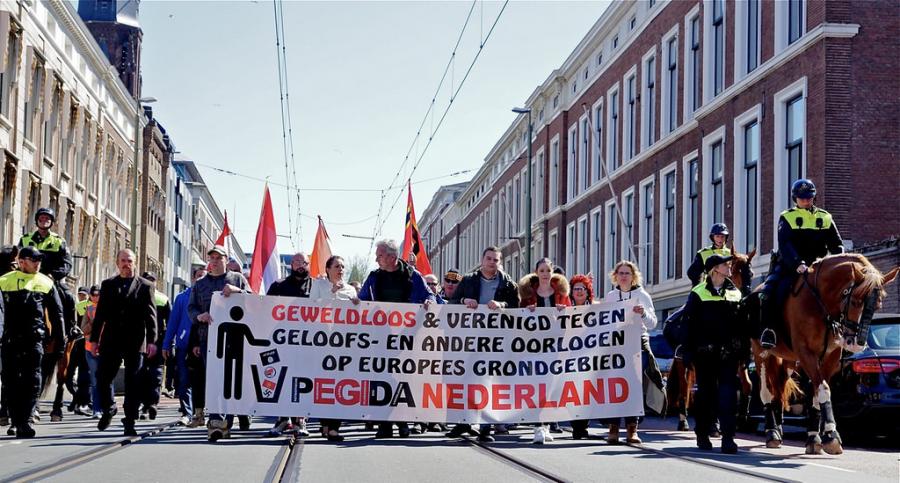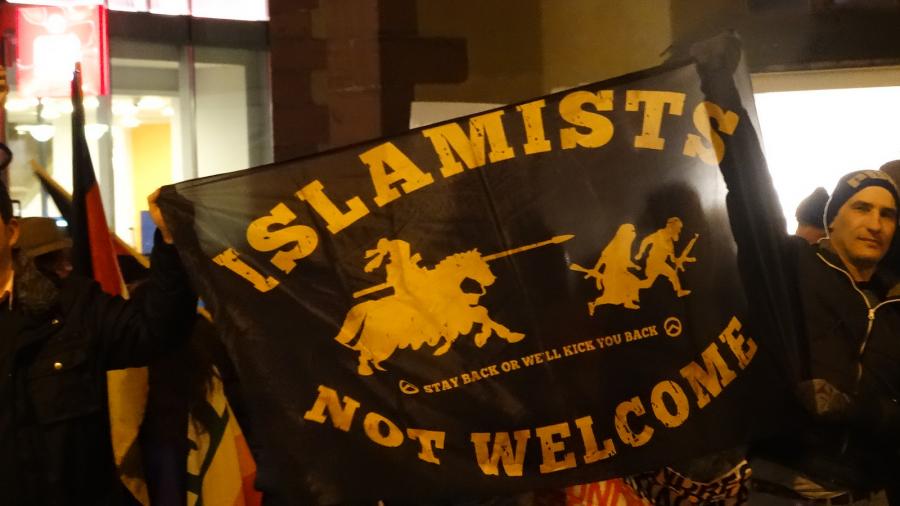
What keeps Pegida together?
An approach to collective identity of the populist movement
When hundreds of people come together shouting various slogans, waving flags and demanding a “Fortress Europe” then another Pegida rally is on the streets. The German right-wing populist movement was launched in the fall of 2014 in Dresden and has since spread to other cities and countries. With its emergence, the question of coherence has appeared: what holds this group together?
The self-proclaimed ‘Patriotic Europeans against the Islamisation of the Occident’ (Pegida) movement declares itself against the alleged Islamisation of Europe and demands a restoration of ones ‘own’ cultural values and norms. Religious wars on national soil, Angela Merkel’s migration policy, and a Muslim takeover undermining traditions and heritage are the main concerns of the movement which, after more than one year, still exists and organises rallies in Germany and other European countries. What is the reason for their coherence, which draws people to the anti-immigrant populist collective?
According to Pegida, the cultural attributes of 'the others' stand in stark contrast to what western culture stands for.
To comprehend the phenomenon of the emergence and the continuance of Pegida, the term of collective identity needs to be explored. Collective identity serves as a basis and as a tool for collective movements in general and for Pegida in particular. Although the concept of collective identity is fragile and “slippery”, it is important in order to understand the movement. In short, identity is a process that “provides categories by which individuals divide up and make sense of the social world”. People who share the same provided categories have a mutual perception of ‘reality’ and create a feeling of belonging. This feeling is the connection between the members of a movement and the core of a collective identity, which can be understood as the factor that holds it all together.

What is the collective identity of Pegida?
The collective identity of Pegida serves as political mobilisation and is based on two major juxtapositions. Both are constituted through the perception of ‘us’ against ‘them’ with the implication of ‘us’ being better than ‘them’. By arousing a mutual understanding, as well as feelings of solidarity and belonging, through defining such moral boundaries in a world which is perceived as chaotic and full of conflic, Pegida creates a cognitive map, a structure and understanding, which binds and activates members of its social movement.
This boundary and structural work is the core of Pegida’s collective identity. Without 'the others', there would be no ‘us’, no self-identification. It is a tool to establish who one is and who one is not. The definition of oneself is “relative to their opponents and broader society”. Pegida uses boundary work and especially a juxtaposition of oneself and one's opponents, 'the others', in order to create a definition of and ultimately an identity for oneself. Without 'the others', there would be no such social movement and no collective identity. To sustain Pegida’s identity the comparison and differentiation with 'the thers' is needed. Therefore, they are bound to 'the others' they proclaim to dislike so much. This “idea of opposition” states that the characteristics of 'the others', their values, norms, and behaviour, is incomparable and inferior to our own. The way they portray 'the other' can be seen as mostly stereotypical and consisting of frozen images of the Others. These oppositional frames serve to exclude and bond people, as well as to develop an “awareness of certain differences” and an “‘oppositional consciousness’”.
Who are the Others?
The two major juxtapositions lead to a unique type of image of ‘us’ and 'the others'. Who are 'the others'? The first juxtaposition is between ‘us’, the people, and ‘them’, the government. Concerns and mistrust regarding the current government and its policies are aspects which are used by the Pegida movement, to engage people and create an oppositional consciousness. The government (or part of it) became one of the targets of the movement and is seen as a cause of current struggles and demise. With statements such as “Merkel muss weg” (Merkel must leave) the group distances itself from the current establishment and therefore provides an oppositional frame that explains the problem, which according to Pegida lies with Merkel’s policies. Merkel is seen as the enemy, because of the decisions she has made regarding refugees and their, mostly, Islamic background.
Slogans such as Grenzen zu" (Close the borders), are used to show that Pegida also provide a solution to the alleged problem: the replacement of Merkel and the abolition of her politics, particularly the closing of the borders and therefore also putting a stop to the inflow of refugees. This demand of the rectification of dominant structures is also based on the alleged recognition of injustice and falsehood within these structures.
Through a clash of cultures, boundaries emerged in people’s consciousnesses.
The arrival of thousands of migrants from outside of Europe gave way to another and probably even stronger oppositional frame in Pegida’s process of collective identity. It is the differentiation between the Occident and the Orient. However, for the purpose of the movement the culture of the Orient is broken down into a simpler version: the Arabic culture and more specifically Islam, which they see as unseparable from Arabic culture. Through a clash of cultures, cultural and moral boundaries emerged in people’s consciousnesses. Unknown people, who do not share the same cultural background and thus the same heritage and identity cause a strong feeling of insecurity, forfeiture and the erosion of the once stable concept of a unifying culture.
The fear of losing one´s own national culture andidentity, as well as one's economic privileges, has become more more widespread in society. This goes hand in hand with the notion that what is ‘ours’ has to be “protected against the negative influences of the intruders, the immigrants, the conquerors of the national territory”. The awareness of certain differences in collective identities implies that one’s own characteristics are superior to the one of 'the others'. One’s own culture is more well-developed, more valuable, and all in all simply better than any other culture, especially that of 'the others'. The culture of 'the other' contains negative features, that are allegedly dangerous, inferior to, and not compatible with ‘our’ lifestyle.

What are ‘our’ and ‘their’ features?
Xenophobic and islamophobic slogans and banners among Pegida members, as well as speeches, show the sentiments and understandings that were discussed in the section above. They promote the exclusion of aliens and a reversion to traditional national circumstances. A certain discomfort and anxiety, due to the presence of a foreign culture, which is perceived as a threat to one´s own identity and which is therefore rejected, are being addressed. In rallies all around Europe demonstrators held up signs such as “Mohammed not welcome”, “Rapefugees not welcome”, "Islamists not welcome. Stay back or we'll kick you back", "Multikulti stoppen. Meine Heimat bleibt deutsch“ (Stop multiculti. My home remains German) or “`Rape culture’ is being imported".
Rallies are filled with slogans and speeches, stating what Pegida rejects. But what do they stand for? They want to convey a message that they are what 'the others' are not – two of these things being German (and European) and Christian. Part of those two main characteristics are the principles of democracy, freedom, human rights, freedom of speech, security, monogamy, courage, and heroic deeds. These attributes are not only felt, but also used by activists as strong and undeniably approving words to frame their cause in an oppositional and positive way. The cultural attributes of 'the others' stand in stark contrast to these aspects of western culture according to Pegida. These attributes include: discrimination, oppression, tyranny, terror, darkness, and slavery – everything that is negative, untenable, and considered as part of an ancient time.
“Our own culture is the best culture there is”
Geert Wilders, Dutch Politician and leader of the Party of Freedom, visited Dresden in April 2015 to give a speech where he used phrases such as “Unsere Freiheit und Demokratie muss verteidigt werden“ (Our freedom and democracy need to be defended), “Wahrheit ist stärker als Lüge” (The ruth is stronger than lies), “Mut ist stärker als Tyrannei” (Courage is stronger than tyranny), “Freiheit ist stärker als Unterdrückung” (Freedom is stronger than oppression), “Kämpfen für unsere Freiheit” (Fight for our freedom). He continued with saying that people coming into the country should adapt to ‘our’ culture and our norms and values, not the other way around, because „unsere eigene Kultur ist ja die beste Kultur” (Our own culture is the best culture there is) and „Wir möchten bleiben was wir sind und wir möchten bleiben wer wir sind“ (We want to stay what we are and what we are). His words create clear boundaries between ‘us’ and ‘them’ and ‘ours’ and ‘theirs’, which relates to the collective identity of Pegida.
The construct Pegida
The emergence and coherence of Pegida are tied to its collective identity. This identity is a construction, which is formed in the context of certain discourses, but is nevertheless felt as being very realistic by certain people. Pegida provides a cultural discourse, which helps to create a sense of oneself and of 'the others'. It builds an oppositional consciousness and framing that leads to a 'we-ness', with which the members can identify themselves. This identification takes place on a cognitive, emotional, and moral level and is “produced and reproduced in ongoing interactions between allies, oppositional forces, and audiences who can be real or imagined”. Shared meanings and interests, as well as boundary constructions are the basis of a collective identity of social movements and serve as strategic activities. The collective identity of Pegida includes a feeling of belonging to the same heritage and culture, an oppositional consciousness towards 'others' and a rejection of those in power, which is created through an oppositional framing and eventually used for group mobilisation.